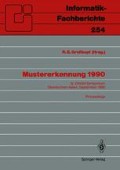Abstract
Surface interpolation techniques provide a method of integrating and interpolating visual information, and have therefore been the focus of much research in computer vision. I show that the finite element method (FEM) may be used to derive closed-form optimal RMS error estimates of surface shape and velocity. By posing the interpolation problem using wavelets as eigenvectors of the system of equations this dosed-form solution may be computed by use of recursive application of separable quadrature mirror filters (QMF’s) to form a QMF pyramid. This solution requires only O(n log n) operations and O(n) storage locations per image Similar solutions are available for three dimensional objects.
Access this chapter
Tax calculation will be finalised at checkout
Purchases are for personal use only
Preview
Unable to display preview. Download preview PDF.
References
D. Terzopoulos, The Computation of visible surface representations. IEEE Trans. PAMI, 10 (4): 417–439, 1988.
R. Szeliski. Fast surface interpolation using hierarchical basis functions. IEEE Trans. PAMI, 12(6):513— 528, 1990.
R. Szeliski. Regularization uses fractal priors. AAAI ‘87, 749–754, 1987.
T. Poggio, V. Torre, and C. Koch. Computational vision and regularization theory. Nature, 317:314319, Sept. 26, 1985.
W. E. L. Grimson. An implementation of a computational theory of visual surface interpolation. Computer Vision, Graphics, and Image Processing, 22: 39–69, 1983.
A. Grossmann and J. Morlet. Decomposition of Hardy functions into square integrable wavelets of constant shape. SIAM J. Math, 15: 723–736, 1984.
Y. Meyer. Principe d’incertitude, bases hilbertiennes et algegres d’operateurs. Bourbaki Seminar, No. 662, 1985–1986.
A. P. Pentland. Fractal-Based Description of Natural Scenes. IEEE Trans. PAMI, 6 (6): 661–674, 1984.
A. P. Pentland. A New Sense for Depth of Field. IEEE Trans. PAMI, 9 (4): 523–531, 1987.
Klaus-Jürgen Bathe. Finite Element Procedures in Engineering Analysis Prentice-Hall, 1982.
Larry J. Segerlind. Applied Finite Element Analysis. John Wiley and Sons, 1984.
A. P. Pentland. Automatic Extraction of Part Deformable Models. International Journal of Computer Vision, 4: 107–126, 1990.
S. G. Mallat. A theory for multiresolution signal decomposition: the wavelet representation. IEEE Trans. PAMI, 11 (7): 674–693, 1987
A. P. Pentland and J. R. Williams. Good Vibrations: Modal Dynamics for Graphics and Animation. Computer Graphics, 23 (4): 215–222, 1989.
E. P. Simoncelli, E. H. Adelson, Non-Separable Extensions of Quadrature Mirror Filters to Multiple Dimensions Proceedings of the IEEE, 78 (4): 652–664, April 1990
Bernard Friedland. Control System Design McGraw-Hill, 1986.
Masanao Aoki. Optimization of Stochastic Systems: Topics in Discrete-Time Dynamics Academic Press, second edition, 1989.
R. E. Kalman. A New Approach to Linear Filtering and Prediction Problems. Transaction ASME (Journal of Basic Engineering), 82D (1): 35–45, 1960.
R. E. Kalman and R. S. Bucy. New Results in Linear Filtering and Prediction Theory. Transaction ASME (Journal of Basic Engineering), 83D (1): 95–108, 1961.
A. Croisier, D. Esteban, and C. Galand. Perfect channel splitting by use of interpola- tion/decimation/tree decomposition techniques. In International Conference on Information Sciences and Systems, pages 443–446, Patras, August 1976.
D. Esteban and C. Galand. Application of quadrature mirror filters to split band voice coding schemes. In Proceedings ICASSP, pages 191–195, 1977.
Martin Vetterli. Multi-dimensional sub-band coding: some theory and algorithms. Signal Processing, 6 (2): 97–112, February 1984.
Edward H. Adelson, Eero Simoncelli, and Rajesh Hingorani. Orthogonal pyramid transforms for image coding. In Proceedings of SPIE, October 1987.
H. Gharavi and A. Tabatabai. Application of quadrature mirror filters to the coding of monochrome and color images. In Proceedings ICASSP, pages 32.8.1–32.8. 4, 1987.
Anh Tran, Kwun-Min Liu, Kou-Hu Tzou, and Eileen Vogel. An efficient pyramid image coding system. In Proceedings ICASSP, pages 18.6.1–18.6. 4, 1987.
Author information
Authors and Affiliations
Editor information
Editors and Affiliations
Rights and permissions
Copyright information
© 1990 Springer-Verlag Berlin Heidelberg
About this paper
Cite this paper
Pentland, A. (1990). Physically-Based Dynamical Models for Image Processing and Recognition. In: Großkopf, R.E. (eds) Mustererkennung 1990. Informatik-Fachberichte, vol 254. Springer, Berlin, Heidelberg. https://doi.org/10.1007/978-3-642-84305-1_21
Download citation
DOI: https://doi.org/10.1007/978-3-642-84305-1_21
Publisher Name: Springer, Berlin, Heidelberg
Print ISBN: 978-3-540-53172-2
Online ISBN: 978-3-642-84305-1
eBook Packages: Springer Book Archive

